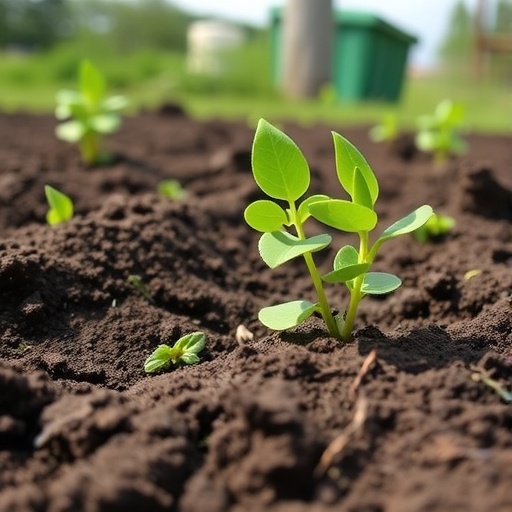In recent years, the landscape of environmental remediation has witnessed a seismic shift towards sustainable practices, particularly in the realm of soil remediation. As urbanization continues to escalate and industrial contamination permeates ecosystems, researchers are faced with the imperative to develop innovative, sustainable solutions. The pioneering work by Ostovar et al., featured in the forthcoming article in Environmental Science and Pollution Research, sheds light on biopile-based soil remediation technologies and the integration of artificial intelligence, driving a new era of environmental restoration.
The concept of a biopile is rooted in the principles of bioremediation, a process that utilizes microorganisms to degrade and detoxify pollutants in the environment. Over the past decade, the efficacy of biopile systems has been significantly enhanced through the adoption of modern technology and methodologies. This research underscores the myriad improvements made, marking a decade rich with transformation and advancement. The systematic modifications have elevated biopiling from a passive recovery method to a dynamic, efficient, and highly effective remediation strategy.
At the core of this research is the invaluable combination of bioremediation practices with cutting-edge artificial intelligence (AI) tools. AI has infused sophistication into biopile management, allowing for precise monitoring and optimization of microbial activity and pollutant breakdown. By leveraging machine learning algorithms, researchers can analyze vast datasets to predict biopile performance, thereby fine-tuning parameters such as aeration, moisture content, and nutrient levels. This predictive capability enables remediation efforts to be not only faster but also remarkably resource-efficient.
Ostovar and colleagues delve into the latest research and findings surrounding the physiological needs of microorganisms within biopile environments. By optimizing these conditions, the degradation rates of hazardous compounds can be significantly increased. This is paramount in addressing pressing issues such as petroleum hydrocarbons, heavy metals, and other legacy contaminants that have long posed threats to soil health and human safety. Their work clarifies that a well-supported microbial community can act as a formidable ally in the battle against environmental pollution.
Furthermore, the integration of AI into biopile systems presents a transformative shift in how we visualize soil remediation processes. Machines and algorithms can now autonomously control key aspects of remediation strategies, reducing the need for manual oversight. This automation not only enhances efficacy but also minimizes human error, a frequent concern in environmental management. The researchers highlight multiple case studies where AI has played an instrumental role in increasing the success rates of remediation efforts.
The decade of advancements in biopile technology has also opened doors for interdisciplinary collaboration. Ostovar et al. emphasize the need for combined expertise from environmental scientists, engineers, and data analysts to foster innovative solutions in soil treatment. This collective approach has already yielded promising results, allowing researchers to develop more robust strategies tailored to specific contaminants and site conditions. The evolution of this collaborative culture underscores the reality that environmental challenges do not exist in isolation; they necessitate a comprehensive, multidisciplinary response.
One notable section of the research discusses the challenges that remain despite these advancements. Biopile systems, while revolutionary, are not a panacea for all soil contamination problems. Certain pollutants may demonstrate resistance to degradation, and the natural variability of soil conditions can complicate remediation efforts. Ostovar and team suggest that a more nuanced understanding of the interactions between pollutants, soil types, and microbial communities is crucial for achieving optimal results. Their call for ongoing research and development is a testament to the complexity of environmental challenges faced today.
The article also emphasizes the importance of stakeholder engagement and public awareness in bioremediation initiatives. Effective communication about the benefits and limitations of biopile technologies is essential for fostering public trust and facilitating community involvement in remediation projects. By demystifying the science and showcasing successful outcomes, researchers can garner support and create a more informed populace that understands the nuances of soil health and environmental conservation.
As the world grapples with the consequences of climate change and mismanaged industrial practices, the quest for sustainable soil remediation has never been more critical. Ostovar et al.’s insights serve as a clarion call to the global community, urging a collective commitment to cleaner, healthier ecosystems. Their work stands as a beacon of hope, illustrating how innovative technology, when coupled with dedicated research, can yield meaningful progress.
Additionally, the researchers advocate for policy frameworks that support the integration of these new technologies within environmental regulations. By aligning governmental policy with innovative bioremediation practices, a more robust and proactive approach to environmental management can be established. Such policies would encourage investment in research and development, driving the advancement of greener technologies that promise both economic and ecological resilience.
In conclusion, the research spearheaded by Ostovar and colleagues represents a critical juncture in the field of environmental science. By documenting a decade of improvements in biopile-based soil remediation and intertwining these advancements with AI tools, their work not only informs best practices but also inspires a forward-looking vision for future research. As environmental challenges continue to evolve, so too must our strategies and technologies, ensuring the protection and restoration of our planet for generations to come.
With the promise of artificial intelligence and bioremediation technologies combined, the future of sustainable soil remediation looks brighter than ever. Researchers are confident that ongoing exploration and innovation will yield even greater breakthroughs, transforming the ways in which we approach soil contamination and restoration. As Ostovar et al. aptly illustrate, the decade of advancements they present is just the beginning of a much larger narrative towards environmental healing.
Subject of Research: Sustainable Soil Remediation and Biopile Technologies
Article Title: Advancements in biopile-based sustainable soil remediation: a decade of improvements, integrating bioremediation technologies and AI-based innovative tools.
Article References:
Ostovar, M., Muñana, S., Galdames, A. et al. Advancements in biopile-based sustainable soil remediation: a decade of improvements, integrating bioremediation technologies and AI-based innovative tools.
i>Environ Sci Pollut Res (2025). https://doi.org/10.1007/s11356-025-37002-1
Image Credits: AI Generated
DOI:
Keywords: Biopile, Soil Remediation, Bioremediation, Artificial Intelligence, Environmental Science




